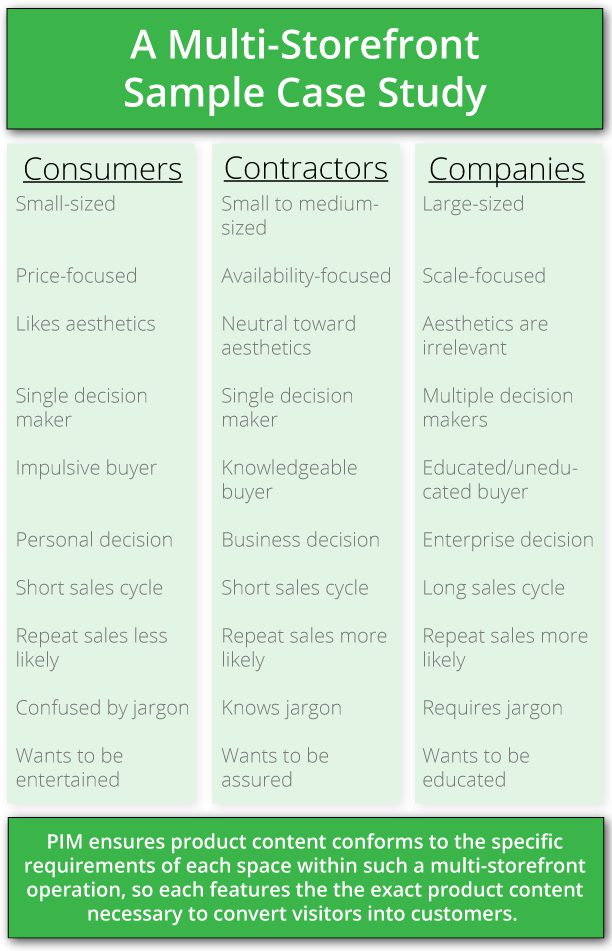If you are running a multi-storefront operation, you are probably fine-tuning your stores’ experiences to the buyer personas. This is because most multi-storefronts are designed with the buyer personas they sell to in mind.
Let’s take, for example, a hypothetical organization called “HVAC Superstore,” which, among other products sells thermocouples. HVAC Superstore is targeting three personas: consumers, contractors, and enterprises.
Based on these personas, the current strategy for most organizations is to differentiate on the following:
- Branding
- Blogging
- Creative Voice
- Persona Resources
- Calls to Action
In 2019 and beyond, to continue to drive conversions, this just isn’t enough.
The bar has Risen.
Progressive organizations are taking this one step further. And that next level centers on product pages. It may sound incredible, but the content on product pages is often overlooked as a key differentiator across storefronts, costing real conversions.
Enter Product Content.
To maximize revenue in today’s global marketplace, content has to be differentiated and compelling at the same time across your multi-storefront operation. Simply put, to maximize revenue and expand market share, companies have to craft product content to sell to different kinds of customers.
From individual consumers to massive global enterprise corporations, if your content doesn’t speak precisely to them, you’re probably losing conversions.
Each multi-Storefront Represents a Different Type of buyer.
Product content that the buyer sees has to be compelling and uniquely targeted to the persona of the buyer. This targeting and storytelling become difficult as storefronts are introduced. But this is critical to drive revenue.
Unique and tailored content is the key to driving conversions.
(Read everything you need to know about tailoring product content in the blog featured below.)
7 Steps to Creating Tailored Content to Grow Sales
What’s more, different customers naturally and automatically expect to see product content presented in a way they can immediately understand and respond to. Targeting different customers with a multi-storefront approach does this.
We see our customers as guests at a party, and we are the hosts. It’s our job every day to make every important aspect of the customer experience a little bit better.
Jeff Bezos (source)
In most cases, the goal of an e-commerce operation or eCatalog is to:
- Maximize Revenue
- Grow Market Share
In this blog, we’ll focus on realizing these sales goals with a product information management (PIM) solution that simplifies publishing across multi-storefronts. But first, it’s key to know exactly who you’re selling to. To illustrate this, let’s continue with our HVAC Superstore example by looking at a case study.

A 3-Part Multi-Storefront Case Study
A thermocouple is a common safety device, like a thermometer, that detects when a pilot light has gone out. The picture above shows a thermocouple for a water heater. Remember, HVAC Superstore has determined it wants to sell thermocouples to 3 kinds of customers:
- Consumers
- Contractors
- Enterprises
An individual consumer is unlikely to buy more than 1 thermocouple at a time, whereas a contractor is likely to buy thermocouples for water heaters, stoves, or furnaces regularly. An enterprise construction company may need to buy 1,000 thermocouples for a new high-rise in one large purchase, or in combination with thousands of other products.
The point is that, because of their individual needs, each type of customer in this case study is going to have a particular concern. Also, while there may naturally be overlap, that specific concern is more likely to be unique to that customer than not.
The Consumer
This customer’s primary focus is on getting their thermocouple at the lowest possible price and will need to be assured of its quality.
The product page for this kind of customer will need to include several images, a guide explaining how to hook up the thermocouple, and a video to demonstrate installation. Further, the images will have to show the consumer exactly what the thermocouple looks like packaged, unpackaged, and, most importantly, what it’s going to look like after proper installation.
Multiple payment and delivery options are part of delighting individual customers. They’ll be concerned with warranties, returns, and refunds. Ultimately, the consumer is more likely to buy and less likely to return the thermocouple if your product pages make a clear, attractive promise that your company and products can keep.
Let’s be real, most consumers are not trying to dig through a bunch of tech specs. They just want to feel confident they’re making the right choice, without overthinking it. So, your product pages should be super easy to navigate. Keep the titles and descriptions clear, the images clean and helpful, and make sure it all just makes sense at a glance, that quick “yep, this is what I need” feeling, that’s the goal.
The Contractor
This customer wants to be certain the thermocouple is available for pick up immediately, or that delivery is available for precisely the right time and place. The contractor will also require the thermocouple to arrive in perfect condition and ready for installation.
The product page for this kind of customer will need to include all necessary installation information and precise specifications, like a CAD drawing. Suppose the house where the thermocouple will be installed is in a city, county, or state with complex regulations about installation. In that case, your product pages should address this concern to maximize conversions.
Contractors are also knowledgeable, so product content has to include a certain level of industry-specific jargon to assure them your company knows everything about what it’s selling. Ultimately, the contractor isn’t going to buy your thermocouple if your product pages don’t assure them they won’t have to waste time and lose money waiting because the thermocouple is out of stock.
The Enterprise Company
This customer may have specialized pricing schemes to take advantage of buying at geographic or volume scale, or both, and certain specific delivery requirements.
Beyond product pages, enterprise customers are likely to expect a gated view of your site. Once logged in, they will want product pages customized to negotiated requirements. Enterprise companies will also expect your product pages to include a high degree of product content to educate them about your thermocouples.
Notice how little the two paragraphs above actually discuss the product itself. The impersonal focus of the enterprise company is just one demonstration of the wide variability in customer-specific requirements.
You can’t sell to a person the same way you can sell to a company, so your product pages have to reflect that fact.
Here is a breakdown of the differences inherent to the 3 kinds of customers in our case study.

Multi-Storefront Sales Tailored by Customer
The case study above is only an example, as e-commerce operations often sell simultaneously to many different kinds of customers. The more store considerations you have to account for, the more multi-storefronts you will need, and the more complex your operations become.

Because customers range in size, even though there is some overlap, each tends to have a specific main concern. These main concerns are best met with product content presented in a particular way across a company’s multi-storefront.
Individual Consumers
People shopping online tend to place price above all other concerns but don’t forget to highlight quality and functionality in product descriptions. Individuals also like lots of images, but videos are the biggest sellers today.
Students
Like individual consumers, students care about prices. But students are also eligible for discounts, so don’t forget to address those. Students also tend to buy one of everything per year, so highlighting a 1-year guarantee is key.
Small Contractors
Contractors have to know that products are available and will be delivered precisely on time. They’ll also need as much installation and regulatory information as necessary to opt for your products.
Nonprofit Organizations
Nonprofits and NGOs are often focused on local, regional, national, and international issues. So your product content has to speak to their values concerning one or all of these.
Media Companies
News outlets focus on the issues their readers and viewers are concerned with. So your product content has to assure them that those issues are important to you, too.
Schools
Public schools are highly regulated by local governments, so product pages need to include regulatory compliance information. Universities, on the other hand, are often focused on prestige. So they tend to associate with brands with strongly established reputations for high quality.
Law Enforcement
Like public schools, law enforcement is tightly regulated. But unlike them, selling to adults instead of children means your product pages will have to focus on quality over aesthetics.
Hospitals
Hospitals are subject to a heavy amount of oversight because so much of what they buy has the potential to kill people. As such, your product pages will have to place extraordinary emphasis on compliance to ensure customers your products meet every regulation.
Enterprise Companies
These customers will want to negotiate the best possible deal at scale, requiring a long sales cycle and the development of a close business relationship.
Military
Buyers of this kind are likely to be even more focused on scale than enterprise companies because military equipment is subject to intentional destruction.
Government
Finally, because governments are the most bureaucratic institutions on Earth, you’ll have to develop relationships with dozens, or even hundreds, of individuals and departments. This level of required detail means omitting even a single piece of product information on any of your product pages could be the difference between a sale and not. Regardless of who you’re selling to, PIM is ultimately the solution for simplifying the optimization of product content for all the product pages making up your complex multi-storefront operation.
An incomplete list of different kinds of customers and specific example concerns includes the following.
Individual Consumers
People shopping online tend to place price above all other concerns, but don’t forget to highlight quality and functionality in product descriptions. Individuals also like lots of images, but videos are the biggest sellers today.
Students
Like individual consumers, students care about prices. But students are also eligible for discounts, so don’t forget to address those. Students also tend to buy one of everything per year, so highlighting a 1-year guarantee is key.
Small Contractors
Contractors have to know products are available and will be delivered precisely on time. They’ll also need as much installation and regulatory information as necessary to opt for your products.
Nonprofit Organizations
Nonprofits and NGOs are often focused on local, regional, national, and international issues. So your product content has to speak to their values concerning one or all of these.
Media Companies
News outlets focus on the issues their readers and viewers are concerned with. So your product content has to assure them those issues are important to you, too.
Schools
Public schools are highly regulated by local governments, so product pages need to include regulatory compliance information. Universities, on the other hand, are often focused on prestige. So they tend to associate with brands with strongly established reputations for high quality.
Law Enforcement
Like public schools, law enforcement is tightly regulated. But unlike them, selling to adults instead of children means your product pages will have to focus on quality over aesthetics.
Hospitals
Hospitals are subject to a heavy amount of oversight, because so much of what they buy has the potential to kill people. As such, your product pages will have to place extraordinary emphasis on compliance to ensure customers your products meet absolutely every regulation.
Enterprise Companies
These customers will want to negotiate the best possible deal at scale, requiring a long sales cycle and development of a close business relationship.
Military
Buyers of this kind are likely to be even more focused on scale than enterprise companies, because military equipment is subject to intentional destruction.
Government
Finally, because governments are the most bureaucratic institutions on Earth, you’ll have to develop relationships with dozens, or even hundreds, of individuals and departments. This level of required detail means omitting even a single piece of product information on any of your product pages could be the difference between a sale and not.
Regardless of who you’re selling to, PIM is ultimately the solution for simplifying optimization of product content for all the product pages making up your complex multi-storefront operation.

Multi-Storefronts Tailored to Use Case
As stated above, multi-storefronts work because of an emphasis of focus on specific customer types, but that’s just the beginning. You can also use multi-storefronts to differentiate between any number of other varying factors, such as:
Specific Products
Above, we looked at how you can set up multi-storefronts to serve different kinds of customers. But you can also arrange them to showcase a specific product or group of related products. Selling only a specific group of products together, with descriptions and images that highlight their connections, drives cross-selling.
Geographical Location
Multi-storefronts simplify the international expansion of operations by supporting different languages, currencies, and units of measure. Don’t lose customers who like how your products look, but who can’t read your descriptions.
Technologies
Some customers prefer to shop online with a desktop computer, and some like the flexibility of buying with a phone. Some customers have Android phone,s and some use iPhones. Don’t disappoint customers with product pages that look bad just because they prefer shopping with a phone.
Themes
Many products sell better at specific times of the year or are automatically associated with holidays or other events. Boost seasonal sales with multi-storefronts optimized to appeal to back-to-school shoppers or people who shop for Christmas presents year-round.
Promotional Multi-Storefronts
Use multi-storefronts to set up sites with short-term special offers or temporary sales promotions.
Product Page Optimization
If you aren’t sure about the buyer persona you want to target with a particular product offer, set up multi-storefronts like A/B tests. That way, you can determine how best to optimize product pages to craft and sharpen brand messaging.
Sheer Numbers
Ultimately, it’s the simple math that leads to groundswell. The more multi-storefronts you operate, the higher the likelihood that one or more of them will end up ranking highly on Google. Whether that happens or not, with more multi-storefronts comes a greater chance that customers will simply find one of your stores. All that adds up to more conversions.

How PIM Helps You Avoid Common Multi-Storefront Mistakes
How PIM Helps You Handle Multiple Storefronts?
PIM makes managing multiple storefronts easy by centralizing product info, reducing errors, saving time, and keeping your brand consistent. Here is how:
For Retailers
If you’re a retailer managing multiple storefronts, you know how challenging it can be to keep product info accurate and consistent across every platform. That’s exactly where a PIM for retailers becomes your secret weapon. It gives you one central place to manage all your product details, images, descriptions, specs, you name it, so everything stays in sync. Update it once, and boom, it goes everywhere.
No more copy-paste chaos or scrambling to fix things last minute. Your brand stays sharp, your info stays accurate, and your customers get a smooth, trustworthy shopping experience. Easy win.
For Brands
When you’re building a brand, storytelling is everything. A PIM for brands lets you tell that story exactly the way you want across all your channels. Whether you’re launching in new markets or refreshing your product line, do it all from one central hub so no more back-and-forth with 10 spreadsheets and 5 teams, you stay on-brand, on-message, and totally in control. Think of it as your behind-the-scenes content command center.
For Distributors
Distributors, we know your catalogs are massive. Managing thousands of SKUs across channels can get messy fast. A PIM for distributors keeps your product data clean, organized, and easy to push out wherever it needs to go.
It cuts down the grunt work, kills off dumb mistakes, and helps you move faster. Less chaos, more sales. It’s like upgrading from a flip phone to a smartphone, you won’t believe how you ever lived without it.
What Even Is PIM?
Good question! So, PIM stands for Product Information Management. But don’t let the fancy name throw you off. It’s basically your product info HQ. One place where you store, edit, and sync everything your team (and your customers) need to know about what you are selling. So whether you’re running a few shops or managing thousands of products, a solid PIM product keeps things clean, current, and stress-free. It’s like having your product content on autopilot.
Succeeding in today’s ecommerce space is as much about figuring out how to do things right as not starting off by doing things wrong. Here is a list of common mistakes you can solve by implementing a PIM solution.
As of 2017, there were approximately 12 to 24 million ecommerce sites online worldwide.
Digital Commerce 360 (source)
Mistake #1: Not differentiating yourself enough
Nothing is going to make selling online easy, but PIM makes it easier to organize product content. With regard to multi-storefronts, PIM removes the endless hassle of managing product information and images. In turn, you can focus on niching your sites.
Building a strong brand is hard, so delegate work to your PIM.
Setting up a successful e-commerce website can take up to 1 year. Entrepreneur.com (source)
Mistake #2: Not automating simple required tasks
Don’t use up your valuable time making sure all your product pages are optimized. Instead, sharpen the focus of your multi-storefront operation by tweaking your page designs and product presentation to drive sales. You can ensure you present visitors with accurate information and up-to-date images and videos with a PIM Software.
Achieving sales success takes time, so let your PIM do the repetitive work.
82.97% of e-commerce website content is duplicate.
E-commerce Platforms (source)
Mistake #3: Running an overly complex multi-storefront
This blog is full of reasons why a multi-storefront operation will drive revenue and grow your market share. But it’s important not to get ahead of yourself. PIM simplifies running even hundreds of sites, but ask yourself why you need so many.
Instead of thinking up ideas for new sites, make sure your sites are built on a robust, revenue-generating necessity.
(Read everything you need to know about picking the right PIM Solutions in the blog featured below.)
PIM Do’s and Don’ts: 7 Steps to Picking the Right PIM

The Bottom Line
If the goal of your eCatalog or e-commerce store is to drive revenue, you have to provide tailored product content that converts for the different kinds of customers you sell to. Simultaneously, you have to keep your multi-storefront product pages optimized with accurate and up-to-date product information. The best way to do this is with a PIM solution.
With PIM supporting the product content syndication behind all these multi-storefronts, you can be sure your product pages are enriched and compelling. This is the case regardless of who sees them, where they see them, how they see them, when they see them, or what their specific likes and interests are. Now that you know just how important a PIM is for driving multi-storefront revenue, click here to see what Catsy can do for you today.

